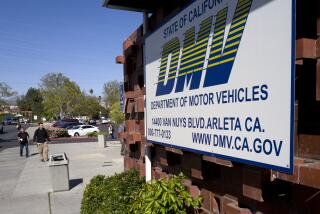Drivers of Special-Needs Kids Go the Extra Mile
- Share via
Jackie Doss has been at work since dawn, bouncing along in her 10-seat yellow school bus, wondering why Timothy wasn’t there for the ride home yesterday and asking herself again what she will do after retirement.
It’s not that the 60-year-old, who plans to move to Henderson, Nev., next year, doesn’t want a break from the workaday world. But Doss, who has been driving students with special needs to and from school for 16 years, doesn’t want to let go of the children.
“We’re not supposed to get involved with our students,” she says. “But if you drive special ed, you can’t help but get involved.”
Statewide, about 29,000 people are certified to drive school buses, according to the Department of Motor Vehicles. Because children with special needs are the only students required under state law to be transported, most of the drivers spend at least some time piloting the more fragile of the state’s youngsters.
Every day in Los Angeles 1,100 drivers go door to door picking up and delivering home again 18,000 children.
“Hi, Jose,” Doss says to a diminutive boy on her San Fernando Valley route. “Looks like your backpack is coming apart, isn’t it, sweetie?” She fiddles with the strap, trying vainly to feed a floppy end into a worn plastic buckle. She sighs, helps the boy with his safety belt and heads back up to the driver’s seat.
Like many in this relatively low-paying field, Doss has a son with a developmental delay and a grandson with special emotional needs. She got into driving after her best friend, who also had a child with special needs, encouraged her to try it.
The job was particularly attractive, she said, because it involved working three hours in the early morning and another three late in the afternoon, leaving plenty of time for grocery shopping, house cleaning and parent-teacher conferences.
Dolores Bolanos started driving buses 25 years ago to take her son, who had special needs, safely to school. She quickly got her license after her son’s regular driver quit. She requested the route that included her own house.
“It was ideal for me,” she said. “He was on the bus legally, and I was able to take him to school and come home and do whatever I had to do.”
She manages San Gabriel Valley operations for Durham School Services, a Texas-based privately run school bus company.
School bus drivers must be certified by the California Highway Patrol, a process that includes fingerprinting, a criminal check, several written tests and a driving test. Drivers must take courses periodically to keep their licenses current, and pay higher fines than automobile drivers if they break traffic laws.
“We tell them they are being held to a higher standard than the average driver, because they are being asked to carry our most precious cargo, our children,” said CHP Sgt. Ron Burch, who used to oversee the licensing process for drivers out of the San Gabriel Valley bus hub of Baldwin Park.
The CHP certification is generally accompanied by extra training to teach drivers how to lift wheelchairs onto a bus or coax an autistic child up the stairs and into his seat.
The drivers are not “the highest-paid people in the world, and they’re not necessarily the most educated, but they definitely take pride in their job,” Burch said. “When they come and take their tests with me, they want to be the best at what they do.”
Those who don’t quit after the first year say they’ve found a calling.
“It becomes part of your life,” said Sandy Fiddler, a transportation analyst for the Orange County Department of Education, who drove severely challenged children to school for 24 years before taking up her current post. “It’s not a job.”
Once early in her career, Fiddler said, she and other drivers helped evacuate children whose homes were threatened by a forest fire. Another time, she took a disabled first-grader home in the afternoon and found to her horror that his mother had moved away while he was at school.
“We went up and we knocked on the door,” she recalled. “I had him by my hand. We could see in there -- the cupboards were open and there was nothing in them.
“We had to have police services come out; the child had been abandoned,” she said. “And what compounded it was there was no way I could find out what happened with him. It was all confidential.... So a child I had transported and come to like was gone, and I could not find out what had happened.”
Peter Isaacson, a 38-year-old artist with a baby on the way and an increasing need for a day job, applied last year to drive a bus for Durham. Eager for the extra 50 cents an hour the company pays to special ed drivers, he took the training, got a route in Pomona and soon was hooked.
“If I was driving a big [bus] for Foothill Transit or [the MTA], I’d probably be earning a lot of money. But there’s a sense of self-worth and satisfaction that you’re making a positive impact on some special-needs kids,” said Isaacson, who lives in Whittier. “Something like that you can’t really quantify in a paycheck.”
He has just one gripe about his job. Like most in this business, he says motorists -- even parents taking their own children to school -- drive unsafely around his bus.
Drivers roll past even when he has his red flashing lights on and stop sign out to indicate that children are entering the bus or crossing the street, he and others said. They zoom around him, passing on the left or right to avoid waiting for the bus.
Such infractions are expensive if drivers are caught. CHP spokesman Steve Kohler said the maximum fine for rolling through a school bus stop sign is $250 for the first offense, $1,000 for the second and drivers’ license suspension for the third.
“There’s a reason we drive like your grandfather,” Isaacson said. “You can’t put a price on somebody’s kid.”
More to Read
Sign up for Essential California
The most important California stories and recommendations in your inbox every morning.
You may occasionally receive promotional content from the Los Angeles Times.










